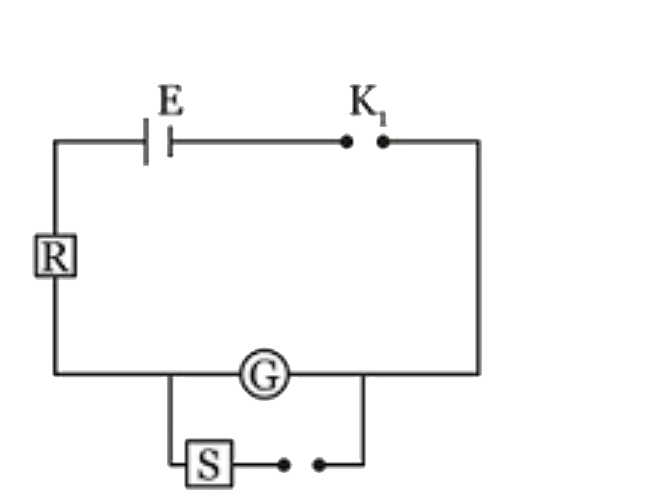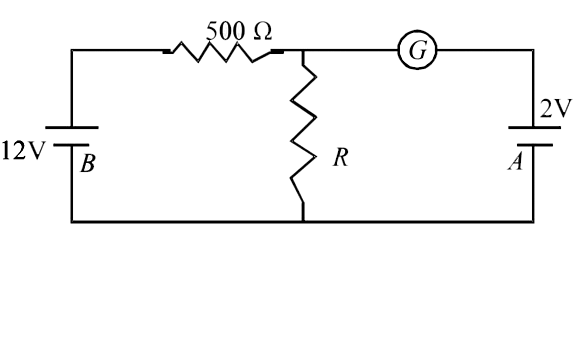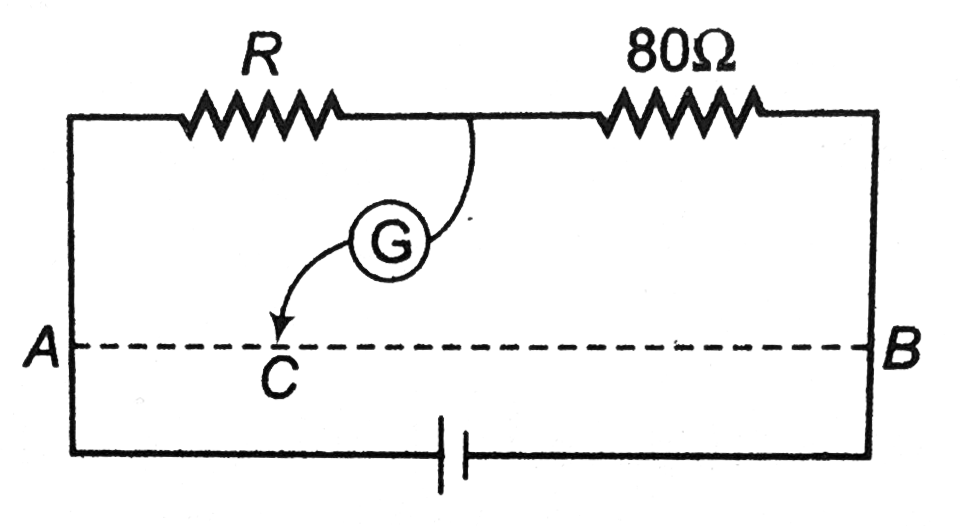To know the resistance G of a galvanometer by half deflection method,a battery of emf VE and resistance R is used to deflect the galvanometer by angle θ.If a shunt of resistance S in needed get half deflection then G,R and S arc related by the equation
S(R+G)=RG
2S(R+G)=RG
2G=S
2S=G
The correct Answer is:B
To find the relationship between the resistance G of a galvanometer, the resistance R, and the shunt resistance S using the half deflection method, we can follow these steps:
1. Understanding the Setup:
- A galvanometer with resistance G is connected in parallel with a shunt resistance S.
- A battery of emf VE and a resistance R are connected in series to the galvanometer.
2. Current Before Adding Shunt:
- The total current I1 flowing through the circuit before the shunt is added can be expressed as:
I1=VER
3. Current After Adding Shunt:
- When the shunt S is added, the current through the galvanometer becomes half, i.e., I12.
- The current through the shunt S will then be I−I12.
4. Voltage Across Galvanometer and Shunt:
- The voltage across the galvanometer VG is given by:
VG=I12⋅G
- The voltage across the shunt VS is:
VS=(I−I12)⋅S
- Since both are connected in parallel, we have:
VG=VS
5. Setting Up the Equation:
- Equating the voltages gives:
I12⋅G=(I−I12)⋅S
6. Substituting for Current:
- Substitute I1=VER into the equation:
12⋅VER⋅G=(VER−12⋅VER)⋅S
- Simplifying gives:
12⋅VER⋅G=12⋅VER⋅S
7. Cancelling Common Terms:
- Cancel VER from both sides (assuming VE and R are not zero):
G=S
8. Final Relation:
- Rearranging gives the final relationship:
S⋅(R+G)=R⋅G
Final Answer:
The relationship between G, R, and S is:
S⋅(R+G)=R⋅G
- A galvanometer with resistance G is connected in parallel with a shunt resistance S.
- A battery of emf VE and a resistance R are connected in series to the galvanometer.
- The total current I1 flowing through the circuit before the shunt is added can be expressed as:
I1=VER
- When the shunt S is added, the current through the galvanometer becomes half, i.e., I12.
- The current through the shunt S will then be I−I12.
- The voltage across the galvanometer VG is given by:
VG=I12⋅G
- The voltage across the shunt VS is:
VS=(I−I12)⋅S
- Since both are connected in parallel, we have:
VG=VS
- Equating the voltages gives:
I12⋅G=(I−I12)⋅S
- Substitute I1=VER into the equation:
12⋅VER⋅G=(VER−12⋅VER)⋅S
- Simplifying gives:
12⋅VER⋅G=12⋅VER⋅S
- Cancel VER from both sides (assuming VE and R are not zero):
G=S
- Rearranging gives the final relationship:
S⋅(R+G)=R⋅G
The relationship between G, R, and S is:
S⋅(R+G)=R⋅G
Topper's Solved these Questions
- BOOK - AAKASH SERIESCHAPTER - MOVING CHARGES AND MAGNETISMEXERCISE - EXERCISE-III49videos
MOVING CHARGES AND MAGNETISM
- BOOK - AAKASH SERIESCHAPTER - MOVING CHARGES AND MAGNETISMEXERCISE - EXERCISE-IB71videos
MOVING CHARGES AND MAGNETISM
- BOOK - AAKASH SERIESCHAPTER - MOTION IN A STRAIGHT LINE EXERCISE - very Short answer type question15videos
MOTION IN A STRAIGHT LINE
- BOOK - AAKASH SERIESCHAPTER - NUCLEAR PHYSICSEXERCISE - ADDITIONAL PRACTICE PRACTICE SHEET (ADVANCED) Integer Type Questions3videos
NUCLEAR PHYSICS
Similar Questions
To measure the resistance of a galvanometer by half deflection method, a shunt is connected to the galvanometer . The shunt is
View SolutionIn a circuit for finding the resistance of a galvanometer by half deflection method, a 6 V battery and a high resistance of 11 kΩ are used. The figure of merit of the galvanometer is 60 μA/division. In the absence of shunt resistance, the galvanometer produces a deflection of θ=9 divisions when current flows in the circuit. The value of the shunt resistance that can cause the deflection of θ/2, is closet to :
View SolutionIn a galvanometer 5% of the total current in the circuit passes through it. If the resistance of the galvanometer is G, the shunt resistance 'S' connected to the galvanometer is
View SolutionIn an experiment to determine the resistance of a galvanometer by half deflection method, the circuit shown is used. In one set of readings , if R=10ΩS=4Ω, then the resistance of the galvanometer is
 View Solution
View SolutionThe deflection in moving coil galvanometer is reduced to half when it is shunted with a 40Ω coil . The resistance of the galvanometer is
View SolutionIn the circuit, the galvanometer G shows zero deflection. If the batteries A and b have negligible internal resistance, the value of the resistor R will be -
 View Solution
View SolutionAB is a wire of uniform resistance. The galvanometer G shows no deflection when the length AC=20cm and CB=80cm. The resistance R is equal to.
 .View Solution
.View SolutionAB is a wire of uniform resistance. The galvanometer G shows no deflection when the length AC=20cm and CB=80cm. The resistance R is equal to.
 .View Solution
.View SolutionA resistance box, a battery and a galvanometer of resistance G ohm are connected in series. the galvanometer is shunted by resistance of S ohm, find the change in resistance in the be required to maintain the current from the battery unchanged.
View SolutionIn the given potentiometer circuit length of the wire AB is 3m and resistance is R=4.5Ω. The length AC for no deflection in galvanometer is
 View Solution
View Solution

